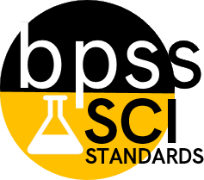Science Practices and Concepts
![]() SEPs1: Asking Questions and Defining Problems
SEPs1: Asking Questions and Defining Problems
Asking questions and defining problems in K-12 builds on prior experiences and progresses to simple descriptive questions.
![]() SEPs2: Developing and Using Models
SEPs2: Developing and Using Models
Modeling in K-12 builds on prior experiences and progresses to include using and developing models (i.e., diagrams, drawing, physical replica, diorama, dramatization, or storyboard) that represent concrete events or design solutions.
![]() SEPs3: Planning and Carrying Out Investigations
SEPs3: Planning and Carrying Out Investigations
Planning and carrying out K-12 investigations to answer questions or test solutions to problems build on prior experiences and progresses to simple investigations, based on fair tests, which provide data to support explanations or design solutions.
![]() SEPs4: Analyzing and Interpreting Data
SEPs4: Analyzing and Interpreting Data
Analyzing data in K-12 builds on prior experiences and progresses to collecting, recording, and sharing observations.
![]() SEPs5: Using Mathematics and Computational Thinking
SEPs5: Using Mathematics and Computational Thinking
Using mathematics and computational thinking in K-12 builds logical reasoning and problem-solving skills.
![]() SEPs6: Constructing Explanations and Designing Solutions
SEPs6: Constructing Explanations and Designing Solutions
Constructing explanations and designing solutions in K-12 builds on prior experiences and progresses to the use of evidence and ideas in constructing evidence-based accounts of natural phenomena and designing solutions.
![]() SEPs7: Engaging in Argument from Evidence
SEPs7: Engaging in Argument from Evidence
Engaging in argument from evidence in K-12 builds on prior experiences and progresses to comparing ideas and representations about the natural and designed world(s).
![]() SEPs8: Obtaining, Evaluating, and Communicating Information
SEPs8: Obtaining, Evaluating, and Communicating Information
Obtaining, evaluating, and communicating information in K-12 builds on prior experiences and uses observations and texts to communicate new information.
CCCs1: Patterns
Structures or events are often consistent and repeated.
CCCs2: Cause and Effect
Events gave causes, sometimes esimple, sometimes multifaceted.
CCCs3: Scale, Proportion, and Quantity
Different measures of size and time affect a system's structure, performance, and our ability to observe phenomena.
CCCs4: Systems and System Models
A set of connected things or parts forming a complete whole.
CCCs5: Energy and Matter
Tracking energy and matter flows, into, out of, and within systems helps one understand their systems behaviors.
CCCs6: Structure and Function
The ways an object is shaped or structured determines many of its properties and functions.
Over time, a system might stay the same or become different, depending on a variety of factors.
| Science and Engineering Practices |
SEPs2:Developing and Using Models
| |
SEPs3:Planning and Carrying Out Investigations
| |
SEPs4:Analyzing and Interpreting Data
| |
SEPs5:Using Mathematics and Computational Thinking
| |
SEPs6:Constructing Explanations and Designing Solutions
| |
SEPs7:Engaging in Argument from Evidence
| |
SEPs8:Obtaining, Evaluating, and Communicating Information
| |

